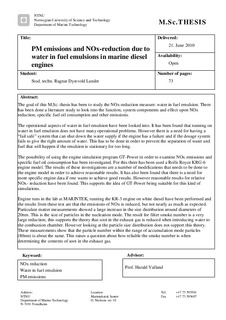| dc.contributor.author | Landet, Ragnar Dystvold | nb_NO |
| dc.date.accessioned | 2014-12-19T12:05:52Z | |
| dc.date.available | 2014-12-19T12:05:52Z | |
| dc.date.created | 2010-12-07 | nb_NO |
| dc.date.issued | 2010 | nb_NO |
| dc.identifier | 375078 | nb_NO |
| dc.identifier.uri | http://hdl.handle.net/11250/237793 | |
| dc.description.abstract | The goal of this M.Sc. thesis has been to study the NOx-reduction measure: water in fuel emulsion. There has been done a literature study to look into the function, system components and effect upon NOx reduction, specific fuel oil consumption and other emissions.
The operational aspects of water in fuel emulsion have been looked into. It has been found that running on water in fuel emulsion does not have many operational problems. However there is a need for having a "fail safe" system that can shut down the water supply if the engine has a failure and if the dosage system fails to give the right amount of water. This has to be done in order to prevent the separation of water and fuel that will happen if the emulsion is stationary for too long.
The possibility of using the engine simulation program GT-Power in order to examine NOx emissions and specific fuel oil consumption has been investigated. For this there has been used a Rolls Royce KRG-6 engine model. The results of these investigations are a number of modifications that needs to be done to the engine model in order to achieve reasonable results. It has also been found that there is a need for more specific engine data if one wants to achieve good results. However reasonable results for relative NOx- reduction have been found. This supports the idea of GT-Power being suitable for this kind of simulations.
Engine runs in the lab at MARINTEK, running the KR-3 engine on white diesel have been performed and the results from these test are that the emissions of NOx is reduced, but not nearly as much as expected. Particulate matter measurements showed a large increase in the size distribution around diameters of 20nm. This is the size of particles in the nucleation mode. The result for filter smoke number is a very large reduction; this supports the theory that soot in the exhaust gas is reduced when introducing water to the combustion chamber. However looking at the particle size distribution does not support this theory. These measurements show that the particle number within the range of accumulation mode particles (80nm) is about the same. This raises a question about how reliable the smoke number is when determining the contents of soot in the exhaust gas. | nb_NO |
| dc.language | eng | nb_NO |
| dc.publisher | Norges teknisk-naturvitenskapelige universitet, Fakultet for ingeniørvitenskap og teknologi, Institutt for marin teknikk | nb_NO |
| dc.title | PM emissions and NOx-reduction due to water in fuel emulsions in marine diesel engines | nb_NO |
| dc.type | Master thesis | nb_NO |
| dc.contributor.department | Norges teknisk-naturvitenskapelige universitet, Fakultet for ingeniørvitenskap og teknologi, Institutt for marin teknikk | nb_NO |
